AGI-1067, a novel antioxidant and anti-inflammatory agent, enhances insulin release and protects mouse islets
- PMID: 20211684
- PMCID: PMC2875300
- DOI: 10.1016/j.mce.2010.02.041
AGI-1067, a novel antioxidant and anti-inflammatory agent, enhances insulin release and protects mouse islets
Abstract
The antioxidant and anti-inflammatory compound AGI-1067 (succinobucol) has potential as an oral anti-diabetic agent. AGI-1067 reduces H(b)A1c, improves fasting plasma glucose, and reduces new-onset diabetes. We investigated AGI-1067 for possible effects on mouse pancreatic islets in vitro. Pretreatment with 10 microM AGI-1067 increased glucose-stimulated insulin secretion (11 mM) without affecting secretion in basal (3 mM) glucose. AGI-1067 enhanced the intracellular calcium response to glucose stimulation in 7 mM and 11 mM glucose, but had no effect in 28 mM or basal glucose. AGI-1067-pretreated islets also showed enhanced calcium responses to methyl pyruvate and alpha-ketoisocaproate at low doses, but not high doses. The AGI-1067-mediated effects on glucose-stimulated calcium were maintained during continuous diazoxide exposure, suggesting effects on the K(ATP)-channel-independent pathway. AGI-1067 also reduced cytokine-induced islet cell death and expression of iNOS, a key component in cytokine signaling. This is the first report of direct stimulatory and protective effects of a first-in-class potential anti-diabetic agent on pancreatic islets.
2010 Elsevier Ireland Ltd. All rights reserved.
Figures
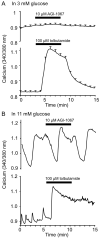

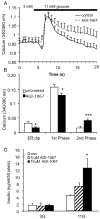
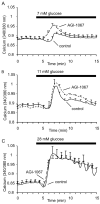

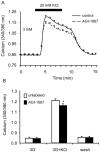

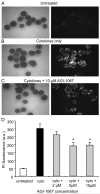
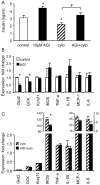
Similar articles
-
Both triggering and amplifying pathways contribute to fuel-induced insulin secretion in the absence of sulfonylurea receptor-1 in pancreatic beta-cells.J Biol Chem. 2004 Jul 30;279(31):32316-24. doi: 10.1074/jbc.M402076200. Epub 2004 Jun 1. J Biol Chem. 2004. PMID: 15175349
-
Alterations of insulin secretion from mouse islets treated with sulphonylureas: perturbations of Ca2+ regulation prevail over changes in insulin content.Br J Pharmacol. 1999 Aug;127(8):1883-91. doi: 10.1038/sj.bjp.0702731. Br J Pharmacol. 1999. PMID: 10482920 Free PMC article.
-
Desensitization of insulin secretory response to imidazolines, tolbutamide, and quinine. II. Electrophysiological and fluorimetric studies.Biochem Pharmacol. 2001 Dec 15;62(12):1695-703. doi: 10.1016/s0006-2952(01)00793-6. Biochem Pharmacol. 2001. PMID: 11755123
-
Glucose activates both K(ATP) channel-dependent and K(ATP) channel-independent signaling pathways in human islets.Diabetes. 1998 May;47(5):758-63. doi: 10.2337/diabetes.47.5.758. Diabetes. 1998. PMID: 9588447
-
Tolbutamide and diazoxide modulate phospholipase C-linked Ca(2+) signaling and insulin secretion in beta-cells.Am J Physiol Endocrinol Metab. 2000 Apr;278(4):E639-47. doi: 10.1152/ajpendo.2000.278.4.E639. Am J Physiol Endocrinol Metab. 2000. PMID: 10751197
Cited by
-
A novel fluorescence imaging approach for comparative measurements of pancreatic islet function in vitro.Islets. 2011 Jan-Feb;3(1):14-20. doi: 10.4161/isl.3.1.14133. Epub 2011 Jan 1. Islets. 2011. PMID: 21266850 Free PMC article.
-
An optimized probucol microencapsulated formulation integrating a secondary bile acid (deoxycholic acid) as a permeation enhancer.Drug Des Devel Ther. 2014 Sep 29;8:1673-83. doi: 10.2147/DDDT.S68247. eCollection 2014. Drug Des Devel Ther. 2014. PMID: 25302020 Free PMC article.
-
Mouse and human islets survive and function after coating by biosilicification.Am J Physiol Endocrinol Metab. 2013 Nov 15;305(10):E1230-40. doi: 10.1152/ajpendo.00081.2013. Epub 2013 Sep 3. Am J Physiol Endocrinol Metab. 2013. PMID: 24002572 Free PMC article.
-
Postnatal maturation of calcium signaling in islets of Langerhans from neonatal mice.Cell Calcium. 2021 Mar;94:102339. doi: 10.1016/j.ceca.2020.102339. Epub 2020 Dec 28. Cell Calcium. 2021. PMID: 33422769 Free PMC article.
-
Pharmacological and Advanced Cell Respiration Effects, Enhanced by Toxic Human-Bile Nano-Pharmaceuticals of Probucol Cell-Targeting Formulations.Pharmaceutics. 2020 Jul 29;12(8):708. doi: 10.3390/pharmaceutics12080708. Pharmaceutics. 2020. PMID: 32751051 Free PMC article.
References
Publication types
MeSH terms
Substances
Grants and funding
LinkOut - more resources
Full Text Sources
Other Literature Sources
Medical
Research Materials

